Site menu:
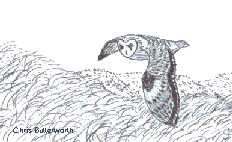
November 2009 Newsletter
Species Spotlight - Short-eared Owl.
Point of Ayr Voluntary Wardens wanted.
October Bird News.
Forthcoming Events.
Latest Newsletter.
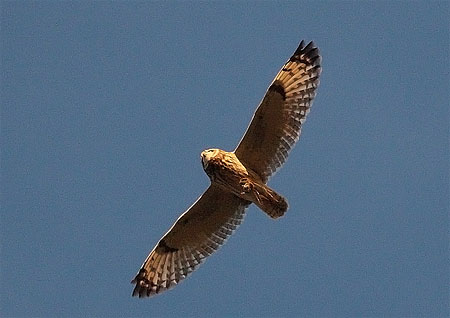
The Dee Estuary is renowned for it's wintering Short-eared Owls. It's this species, probably even more than Water Rails or Hen Harriers, that the visiting birders come to see during the Parkgate High Tide Birdwatches. Here they are flushed by spring tides covering the marsh and often fly close to the watching hordes giving fantastic views. Over the past few years increasing numbers have also been seen on Burton Marsh where they hunt during the day, some flying very close to Denhall Quay and Denhall Lane. In my experience the best time to see them at Burton is on a still and overcast afternoon, usually best at 3pm or later.
The graph below shows the maximum counts on the estuary for the past 20 years - and you will see that the last winter (2008/09) was a truly remarkable one with a maximum count of 30 on Nov 16th with 27 at Burton and three off Parkgate at the same time. It is probable that between Burton and Heswall there may well have been at least 50 on the marshes through the winter. Double figure counts were made in every month from October to April starting with 10 on Oct 5th and finishing with 15 on Apr 13th. There must have been a huge number of small mammals on the marshes to feed this number of owls for so long!
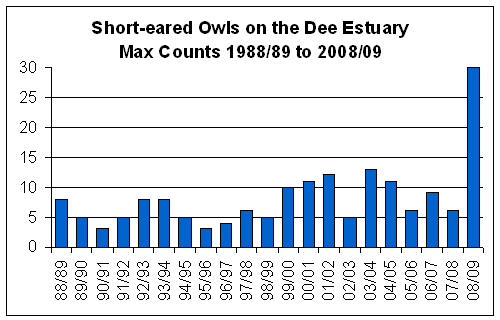
As the winter progressed more Short-eared Owls moved down to Parkgate where we had several double-figure counts with many flying just a few yards from the Old Baths car park, giving wonderful views. Both these photos below were taken at Parkgate, left by Garry Ridsdale © and right by Steve Seal ©.
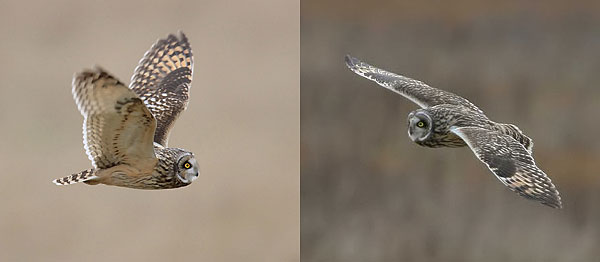
Short-eared Owls often travel long distances and the species is a classic example of an opportunistic wanderer, taking advantage of cyclical population of small rodents both in their breeding and wintering grounds. There are estimated to be in the region of 1,000 to 3,500 pairs breeding in the UK, a portion of these may well move further south for the winter but numbers are more than made up by migrants from the continent, in particular Scandinavia, with at least 5,000 individuals spending the winter in this country. The graph above is interesting as it appears to show a cyclic pattern with, for example, a trough in 95/96 and a peak in 03/04, with only a couple of 'odd' winters spoiling the pattern. However, taking the single maximum count from each winter is a very crude way of demonstrating abundance so we shouldn't be tempted to read too much into the graph, although it is intriguing!
The graph below is a much better way of showing the abundance of these owls through the winter on the Dee Estuary and shows max weekly counts from September to April for the past three winters.
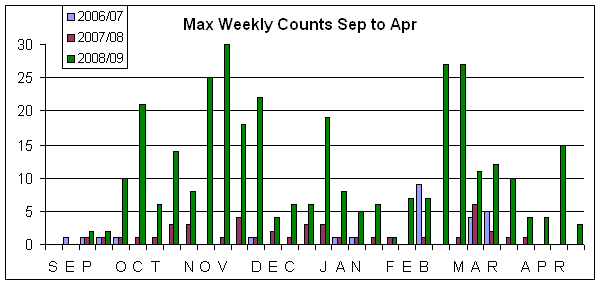
In terms of Short-eared Owl numbers they were three very
different winters.
2006/07 was a poor year for this species, between Oct 1st and Jan 14th there
was just a single bird seen on one day in December. Even in January there was
just a handful of single birds observed before the spring tides in February
flushed nine birds and in March a max of five were seen, again flushed by
the tides. The nine in February was particularly interesting as these were
seen off Heswall where not a single Short-eared Owl had been reported all
winter and it would appear that these were part of a late winter influx.
Probably birds on their way back north to breed.
2007/08 was more of a typical year for this species, albeit with numbers a
bit below average. Three to four birds were present throughout the winter
with again a peak in late winter with six birds flushed by the high tide in
early March.
The graph clearly demonstrates what a remarkable winter 2008/09 was for
this species with high numbers present from October to April. Interestingly
there again appears to have been a late winter peak with two counts of 27
birds in late Feb/early March, both on Burton Marsh.
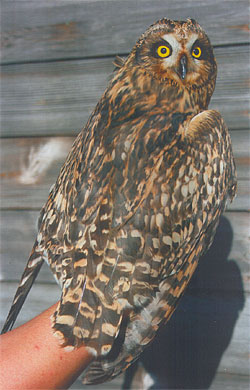 Not
all the Short-eared Owls we get here are recorded just on Burton and
Parkgate marshes. They
can turn up just about anywhere along the shore and fields adjacent to the
estuary, particularly in autumn, early winter and early spring. This one,
left, was ringed on Hilbre Island Oct 5th 2007, © Steve Williams.
Not
all the Short-eared Owls we get here are recorded just on Burton and
Parkgate marshes. They
can turn up just about anywhere along the shore and fields adjacent to the
estuary, particularly in autumn, early winter and early spring. This one,
left, was ringed on Hilbre Island Oct 5th 2007, © Steve Williams.
We cannot say with any certainty where the birds that winter here breed but they are probably a mixture of Northern England, Scottish and Scandinavian breeders. Interestingly, I understand that the Scottish Short-eared Owls had good breeding seasons in 2008 and 2007, in particular those in the Hebrides - so maybe we are seeing some of these. Also surveys of the South Pennine Moors SPA showed a 50% increase in breeding Short-Owls between 1990 and 2004/05, which is good news.
I am looking forward to this next winter to see if we have a return of high numbers again. Unfortunately this seems unlikely as the vole population will have surely crashed by now. Whatever happens I'm sure the winter of 2008/09 will remain long in the memories of local birdwatchers.
Note the two graphs which show 'max counts'. To clarify, these are the highest counts at a single location (apart from the 30 counted on Nov 16th 2008 which was a combined count from Burton - 27 - and Parkgate - 3), actual total numbers for any time period are likely to be considerably higher with many birds spread throughout the marshes between Burton and Heswall, some of which will be on the ground and not observed.
Sources of Information:
1. Personal observations and records sent to me
directly, including data published on this website.
2. Colin E Wells, Short-eared Owl influx onto the Dee estuary Autumn/Winter
2008/09, Birding North West Vol 6 No 3 (April 2009).
3. The Migration Atlas, BTO, 2002.
4. David Norman, Birds in Cheshire and Wirral (Atlas), CAWOS, 2008.
5. Cramp & Simmons, Birds of the Western Palearctic, DVD edition BWPi,
2006.
6. Cheshire and Wirral Bird Reports, CAWOS, 1988 to 2007.
Richard Smith
Point of Ayr RSPB Reserve - Voluntary Wardens Wanted!
Point of Ayr, on the North Wales coast at Talacre, is a great place to watch a variety of birds as they come in to roost at high tide, but unfortunately the site is extremely vulnerable to human disturbance. The RSPB is looking for extra volunteers to help warden this invaluable roost site, and protect the birds throughout the cold winter months.
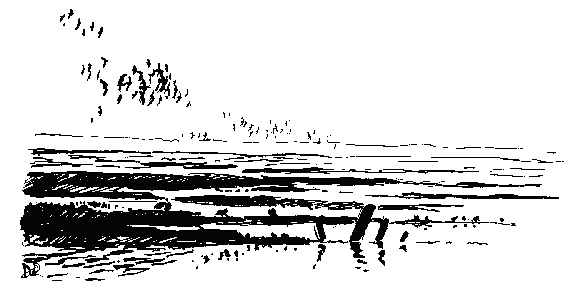
Shifts are run most weekends and typically last between 3-4 hours,
depending on the height of the tide.
If you would like to help in any way please contact the RSPB on 0151 336
7681. Not only are you helping to save the planet, but itís also great
birdwatching too!
Editor - to get an idea of how good an area this is for birds see the Point of Ayr Site Guide.
October Bird News
Firstly a bit of old news from
September, if you remember the first few days were great for seawatching. But it
was even better than I thought as I only recently found out that there was a
Wilson's Storm-Petrel in the Mersey mouth on the Sep 5th (I was away and out of
mobile contact at the time!). This is one of those birds which birders dream
about but rarely see! It was seen by two very experienced birders, Tim Vaughan
and Tony Conway, from the Seaforth side of the river, and I'm sure will be
accepted for Lancashire (it is no longer a BBRC rarity). It may also be accepted
for Cheshire and Wirral. Wilson's Petrels breed in their millions around the
Antarctic, they migrate north during our summer although very few are seen from
land. This is only the second record for the North West, the last being in 1990
off Walney Island. Most UK birds are recorded on pelagic trips off the Scilly
Islands.
There is an excellent article about this record in
Birding North West Volume 6 No. 9.
We also had strong winds in early October although it didn't blow for long enough to bring in good numbers of birds. There were two or three Leach's Petrels, three Great Skua, three Arctic Skuas and a Pomarine Skua. The rest of the month was quiet as far as wind goes, but that meant I was able to get a good count of the Great Crested Grebes off Meols with 268 on the 17th, also at least 150 Common Scoter. On the same day there was a Slavonian Grebe off Hilbre, and at the end of the month there was a Great Northern Diver here.
The two Long-billed Dowitchers which arrived last month at Inner Marsh Farm were still present for most of October, although often just one was seen. They put in a welcome appearance at the Connah's Quay reserve on the 19th and stayed a few days, the latest record was of one back at Inner Marsh Farm on the 30th. Also at Connah's Quay have been up to 5,000 Black-tailed Godwits, 13 Spotted Redshanks and four Greenshank. There was a Kingfisher here for most of the month, and two were seen on the groyne at Meols. A single at Heswall and two at Inner Marsh Farm were the only Curlew Sandpiper records this month. Three Green Sandpipers at Decca Pools on the 28th was a good record for this site.
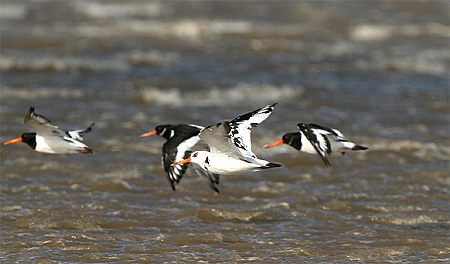
We usually have at least one of these odd looking Oystercatchers on the estuary,
not sure whether it is technically a partial albino or a leucistic bird.
Visible migration was good on two or three days with plenty of Redwings and Fieldfares passing through, the 28th seems to have been the best day with at least 4,000 of these 'winter thrushes' passing over Thurstaston in a few hours. 500 Jackdaws was a good count at Thurstaston on the 17th. The first Snow Buntings of the winter arrived at Wallasey on the 28th and a single on Hilbre on the 31st.
Five Brent Geese on Hilbre on the 1st had increased to 38 by the end of the month. A Great White Egret flew over Hilbre on the 30th, the first record here. Two Spoonbills were at Inner Marsh Farm on the 26th, plus various reports of single birds through the month. On the marshes Hen Harriers had increased to three, two adult females and a juv male - the size difference being quite marked (males being smaller). There has also been a female Marsh Harrier around for most of the month, although this may well have involved more than one bird passing through. Max counts of Short-eared Owls was five at Parkgate and four at Burton, there have also been good views of Barn Owls at Parkgate. 500 Pink-footed Geese were seen to fly west over Burton Marsh on the 5th.

Right: Bar-tailed Godwit at New Brighton, Oct 28th © Steve Seal.
My reason for including the above photos is to demonstrate how different these two Godwit species look when flying. This Black-tailed Godwit is in summer plumage but in winter, of course, the red plumage on the front third of the body will be a uniform grey. But you can see how the black and white on the wings and tail of the Black-tailed Godwit really stands out when the birds are flying, whereas when they are standing they can look rather a dull grey, not unlike Bar-tailed Godwits. Note also how much further the Black-tailed Godwit feet protrude, another diagnostic feature.
Richard Smith.
What to expect in November
Although technically still autumn, November always feels like winter to me and, it seems, to the birds! Mind you, if we get a westerly gale we can still expect our normal 'autumn' sea birds such as skuas and petrels, and maybe a Grey Phalarope - although numbers will be much lower than the same weather in September.
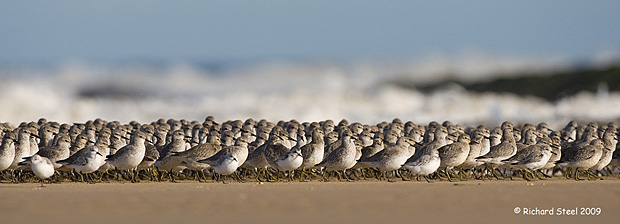
Wader flocks will increase noticeably - particularly Knot, Dunlin, Grey Plover and Bar-tailed Godwit. At low tide see these off Leasowe and Thurstaston on the mud banks, or at their high tide roosts at Hoylake, West Kirby and Point of Ayr.
Hen Harriers and Short-eared Owls will be seen flying over the marshes at Parkgate and Burton. Hopefully we will get at least one adult 'grey' male Hen Harrier. For those wondering why there have been no high tide bird watches at Parkgate this autumn, it is because there have not been any decent high tides. Hopefully next year will be much better (I haven't seen next year's tide table yet), but there are still the Raptor Watches to see at Parkgate, and plenty of birdwatching events elsewhere - see below.
Brent Geese numbers on Hilbre should shoot up through the month, perhaps we will get yet another record high this winter! Another winter visitor is the Snow Bunting, these usually turn up along the north Wirral coast and Point of Ayr, but sometimes they are seen on one of the Hilbre islands, or down the coast on the beach at Thurstaston.
Forthcoming Events
November Highest Spring Tides (Liverpool)
Also see
Tides page.
16th November, 10.31hrs (GMT), 9.2m.
17th November, 11.09hrs (GMT), 9.3m.
18th November, 11.45hrs (GMT), 9.2m.
Forthcoming Events
Organised by the
Wirral Ranger Service ,
Flintshire Countryside Service and/or the RSPB:
All these events and walks have bird interest, even those not advertised
specifically for birdwatching. No need to book for these events unless
specified - please check below.
Friday 6th November. High tide birdwatch on
Hilbre Island.
Join the Rangers and staff from the RSPB for a high tide visit to Hilbre
Island. Among the usual species of wading birds, we should encounter
Purple Sandpipers and also good numbers of Turnstones. (Please note this
is a high tide visit to Hilbre and we will be cut off from the mainland).
Warm clothing and suitable footwear are essential.
There is a £1.50 charge for this event. Sorry no dogs.
Please book early as there are limited places available. For further
enquiries call: 0151 648 4371/3884.
Wednesday 11th November, 9.30am start.
Glorious Mud
There are thousands of waders feeding on the rich mudflats off
Thurstaston Shore and numbers of
Pintail are starting to build up. Join the Rangers on a guided birdwatch
along this fabulous stretch of beach to get close up views of these
special birds.
No need to book, meet at the Wirral Country Park Visitor Centre, Station
Rd, Thurstaston. Wear warm waterproofs and bring some binoculars.
For more info call (0151) 648 4371/3884
Saturday 14th November - Feed
the Birds Day at Ness Botanical Gardens - A cosy little birdwatch by an
open fire. Contact Ness Botanic Gardens to book 0151 794 2000.
Saturday 14th November, 10am start
The Thurstaston Circle
This circular walk takes in Thurstaston Shore
with views of thousands of waders and wildfowl including Redshank,
Black-tailed Godwit and Pintail, then crosses farmland and follows
hedgerows in search of winter thrushes and farmland birds before returning
to the Visitor Centre.
No need to book, meet at the Wirral Country Park Visitor Centre, Station
Rd, Thurstaston. Wear warm waterproofs and bring some binoculars.
For more info call (0151) 648 4371/3884
Sunday 15th November - Raptor Watch at the
Old Baths Car Park, Parkgate.
Last
year was a record year for numbers of short-eared owls and hen harriers,
other raptors included marsh harrier, kestrel, merlin, peregrine, buzzard,
sparrowhawk and barn owl! Join RSPB staff and volunteers to find out all
about the areas brilliant birds of prey. Meet at the
Old Baths Car Park, Parkgate, starts 3pm.
For further details ring 0151 336 7681.
Thursday 19th November, 10am start
Marsh Matters
Join the Rangers and the Wirral Country Park Recording Group at Riverbank
Road Car Park for a high tide birdwatch. As the tide sweeps across the
mudflats many thousands of waders and wildfowl are pushed towards the
Heswall Marshes, right in front of our watchpoint! Fingers crossed we may
encounter a raptor or two.
No need to book, meet at Riverbank Rd car
park, Lower Heswall. Wear warm waterproofs and bring some binoculars.
For more info call (0151) 648 4371/3884
Saturday 5th December. 10:30 am start.
Hoylake Shore Birdwatch.
Join the Rangers, the Dee Estuary Voluntary Wardens and the RSPB to see
the large numbers of wading birds on Hoylake beach. With a rising tide,
we should see the birds at close quarters as they roost and feed.
Beginners welcome. Dress warmly and bring binoculars if you have them.
(HW 12:33 pm @ 9.5m).
No need to book.
Meet on the promenade at King's Gap, Hoylake.
For further information, contact the Coastal Rangers on 0151 678 5488.
Sunday 13th December 2.30pm - Raptor Watch at the
Old Baths Car Park, Parkgate.
Last
year was a record year for numbers of short-eared owls and hen harriers,
other raptors included marsh harrier, kestrel, merlin, peregrine, buzzard,
sparrowhawk and barn owl! Join RSPB staff and volunteers to find out all
about the areas brilliant birds of prey. Meet at the
Old Baths Car Park, Parkgate, starts 2.30pm.
For further details ring 0151 336 7681.

|
 |
The blank (UK) Birding Webring is a collection of quality birding web sites that are based in the United Kingdom. Visit the webring homepage for more information, or A complete list of all the sites in the webring is available by clicking here. previous site in ring : random site in ring : next site in ring |